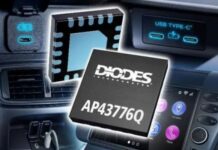There is no doubt that the role of electronics in our everyday technology and lives is increasing, and this growth has been seen phenomenally in the automobile industry as well. A car today is already packed with electronics, and is no longer just a medium to transport people and goods from one place to another, but is now evolving into an IoT device on wheels.
Automotive electronics technologies such as autonomous driving, all-electric cars, and in-car infotainment are the new trends in the automotive industry. Automotive vehicles are transforming into “ultimate electronic devices.” To put a quantitative figure on it, electronics are responsible for 40 percent of a new car’s total cost, according to a recent Deloitte analysis. This figure ranged from 1 % in 1950 to around 18 % in 2000. Today’s electric cars depend on power electronics for the main propulsion motor control, as well as managing the battery system. The future will see autonomous cars, which will rely on powerful computer systems, an array of sensors, networking, and satellite navigation, all connected with each other, and together being a part of the IoT, all of which will require heavy electronics.
Below are some of the emerging as the major trends in Automotive Electronics, and we will see a remarkable leaps being made in the next decade.
ADAS and the increased use of sensors
In recent years, vehicle sensor improvements have led to increasingly advanced autonomous driving technologies that enable higher awareness and visibility. The Advanced Driver Assistance System (ADAS) is designed to reduce the driver’s workload during the driving process itself. Technologies like adaptive cruise control, park assistance, lane-keep assistance, pedestrian detection, and traffic-sign recognition are in the pipeline.
Automotive sensors are ubiquitous now, and are everywhere in today’s cars, constantly monitoring and updating. There are now multiple sensors that are responsible for a lot of critical tasks other than monitoring temperature integrated into automobiles. There are sensors that monitor the angle of the car or sense slipping wheels in bad weather to maintain the driver’s safety.
Advanced Motor Control
An advanced vehicle, apart from its primary drive is filled with dedicated motor-control systems driving pumps, fans, compressors, rotators, actuators and servomechanisms, etc. The desire for maximum efficiency and control, in many cases has motivated engineers to move beyond traditional scalar control systems to sophisticated digital vector control algorithms capable of delivering full torque with acceleration and deceleration at rates that can be precisely managed. The emergence of sensor-less control methods has further opened the door for more cost-effective solutions.
Power Management for Electric Vehicles
As the infrastructure in economically advanced countries changes, and as newer battery systems are developed, we can continue to expect electric vehicles to have longer ranges and faster charging times. This all relies on more advanced power management systems, which rely on a range of fundamental components. These components are not necessarily as highly integrated as SoCs (system on a chip) simply because they need to handle so much power, but high power systems may still need to operate with discrete components on dedicated modules.
Processing Power
Current cars contain somewhere in excess of 100 ECU(Electronic Control Unit)s, and the number is only expected to increase. As the amount of data gathered and processed in automobiles increases, ECUs and other modules in the system will require more processing power. The range of wireless services, power management systems, and processing power required for new vehicles should reveal the complicated electronics landscape in new vehicles. Chipmakers are likely to respond with specialty SoCs, similar to those for IoT and mobile products.
Engine/Energy Management Systems
The constant demand for longer range and lower fuel costs has elevated the importance of a vehicle’s mileage (or miles-per-gallon) ratings in vehicle sales, in addition to motivating a push for more effective digital engine management systems. Besides providing safety-critical supervisory functions for batteries in electric and hybrid vehicles, management systems provide the level of energy monitoring, analysis and control needed to optimize fuel or battery energy utilization.
Infotainment
The consumer’s appetite for enhanced information and entertainment systems is on the rise, as vehicles in a broad range of classes now offer touchscreen displays consoles built into the dash, armrest, seatbacks and even rearview mirrors. At the heart of these solutions, thin-film-transistor (TFT) LCDs provide the required combination of resolution, contrast and screen size. Using touch features of in-vehicle display, manufacturers are providing vehicle occupants with “smartphone-like” graphical interfaces to the vehicle’s infotainment and control system. Semiconductor manufacturers have responded to the growing use of LCDs with highly integrated support for display management.
A number of electronic technologies power vehicles today, and broadly speaking these technologies fall into four domains 1. Driver comfort and safety 2. Electrification of the powertrain (engine and transmission, including the other components) 3. Fuel economy and 4. Infotainment Systems Currently, these are being worked on extensively in a domain center architecture, with a focus to enhance each technology, but going forward we are looking at vehicles with a cross-domain architecture. In the future, vehicles will possess a centralized architecture, and as they will be connected, the vehicle will be interacting with its surroundings and other vehicles in real time. Over the next couple of decades, we are looking at vehicles becoming an integral part of the IoT ecosystem.















